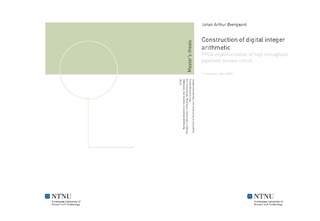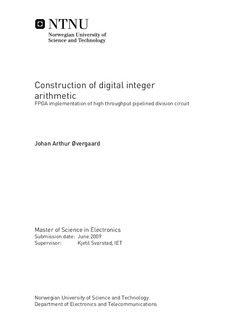| dc.contributor.advisor | Svarstad, Kjetil | nb_NO |
| dc.contributor.author | Øvergaard, Johan Arthur | nb_NO |
| dc.date.accessioned | 2014-12-19T13:43:45Z | |
| dc.date.accessioned | 2015-12-22T11:41:26Z | |
| dc.date.available | 2014-12-19T13:43:45Z | |
| dc.date.available | 2015-12-22T11:41:26Z | |
| dc.date.created | 2010-09-03 | nb_NO |
| dc.date.issued | 2009 | nb_NO |
| dc.identifier | 347845 | nb_NO |
| dc.identifier | ntnudaim:4809 | |
| dc.identifier.uri | http://hdl.handle.net/11250/2369205 | |
| dc.description.abstract | This assignment has been given by Defence Communication (DC) which is a division of Kongsberg Defence and Aerospace(KDA). KDA develops amongst other things military radio equipment for communication and data transfer. In this equipment there is use of digital logic that performes amongst other things integer and fixed point division. Current systems developed at KDA uses both application specific integrated circuit (ASIC) and field programmable gate arrays (FPGA) to implement the digital logic. In both these technologies it is implemented circuit to performed integer and fixed point division. These are designed for low latency implementations. For future applications it is desire to investigate the possibility of implementing a high throughput pipelined division circuit for both 16 and 64 bit operands. In this project several commonly implemented division methods and algorithms has been studied, amongst others digit recurrence and multiplicative algorithms. Of the studied methods, multiplicative methods early stood out as the best implementation. These methods include the Goldschmidt and Newton-Raphson method. Both these methods require and initial approximation towards the correct answer. Based on this, several methods for finding an initial approximation were investigated, amongst others bipartite and multipartite lookup tables. Of the two multiplicative methods, Newton-Raphsons method proved to give the best implementation. This is due to the fact that it is possible with Newton-Raphsons method to implement each stage with the same bit widths as the precision out of that stage. This means that each stage is only halve the size of the succeeding stage. Also since the first stages were found to be small compared to the last stage, it was found that it is best to use a rough approximation towards the correct value and then use more stages to achieve the target precision. To evaluate how different design choices will affect the speed, size and throughput of an implementation, several configurations were implemented in VHDL and synthesized to FPGAs. These implementations were optimized for high speed whit high pipeline depth and size, and low speed with low pipeline depth and size. This was done for both 16 and 64 bits implementations. The synthesizes showed that there is possible to achieve great speed at the cost of increased size, or a small circuit while still achieving an acceptable speed. In addition it was found that it is optimal in a high throughput pipelined division circuit to use a less precise initial approximation and instead use more iterations stages. | nb_NO |
| dc.language | eng | nb_NO |
| dc.publisher | Institutt for elektronikk og telekommunikasjon | nb_NO |
| dc.subject | ntnudaim | no_NO |
| dc.subject | SIE6 elektronikk | |
| dc.subject | Krets- og systemdesign | |
| dc.title | Construction of digital integer arithmetic: FPGA implementation of high throughput pipelined division circuit | nb_NO |
| dc.type | Master thesis | nb_NO |
| dc.source.pagenumber | 75 | nb_NO |
| dc.contributor.department | Norges teknisk-naturvitenskapelige universitet, Fakultet for informasjonsteknologi, matematikk og elektroteknikk, Institutt for elektronikk og telekommunikasjon | nb_NO |

